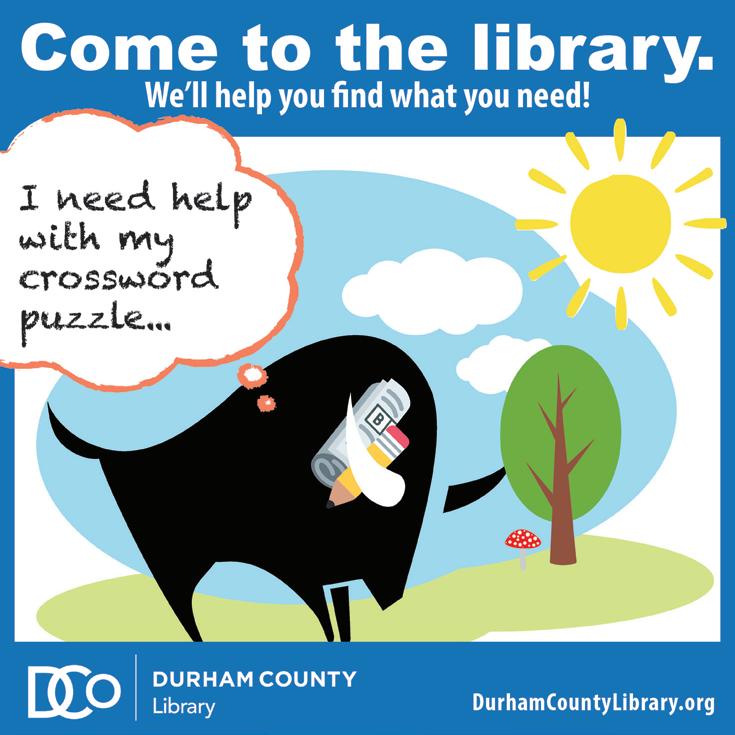




41 NO. 20
4 Durham Public Schools is now offering free breakfasts and lunches, with dynamic menus, to all of its students. BY CHASE PELLEGRINI DE PAUR
5 With Red Hat Amphitheater "saved," Raleigh's next city council will charter downtown's course. BY JASMINE GALLUP
8 As bookstores vanish, the Regulator on 9th Street in downtown Durham endures. BY VALENTINA GARBELOTTO
10 Wake County has a library bond on voters' ballots this fall. How would the $142 million be spent? BY CHLOE COURTNEY BOHL
Best of the triangle 2024 Orange & Chatham counties
14 22 best food & beveragesbest health
18 24 best places best businesses 21 26 best People & misc. best arts
28 Sports journalist John Feinstein's latest book explores the history of Duke's basketball program. BY JUSTIN LAIDLAW
30 A conversation with Anne Byrn, aka the "Cake Doctor." BY LENA GELLER
32 With downtown sneaker store Mad Kicks, brothers Larry Antunez Lopez and Michel Antunez Lopez want to create a streetwear community in Durham BY ANDREA RICHARDS
3 Backtalk 34 Culture calendar
PUBLISHER
John Hurld
EDITORIAL
Editor-in-Chief
Jane Porter
Culture Editor
Sarah Edwards
Reporters
Chloe Courtney Bohl
Lena Geller
Justin Laidlaw
Chase Pellegrini de Paur
Contributors
Mariana Fabian, Jasmine Gallup, Desmera Gatewood, Spencer Griffith, Carr Harkrader, Matt Hartman, Tasso Hartzog, Brian Howe, Kyesha Jennings, Jordan Lawrence, Elim Lee, Glenn McDonald, Nick McGregor, Gabi Mendick, Cy Neff, Sam Overton, Shelbi Polk, Byron Woods, Barry Yeoman
Copy Editor Iza Wojciechowska

Bobby Hurley (left) and Grant Hill (right) at a practice during the 1992 NCAA East Regionals in the Philadelphia Spectrum. (See story, p. 28) PHOTO BY CHUCK LIDDY/THE
CREATIVE
Creative Director Nicole Pajor Moore
Graphic Designer Ann Salman
Staff Photographer Angelica Edwards
ADVERTISING
Publisher John Hurld
Director of Revenue Mathias Marchington
Director of Operations Chelsey Koch
CIRCULATION Berry Media Group
MEMBERSHIP/SUBSCRIPTIONS John Hurld
| indyweek.com P.O. Box 1772 • Durham, N.C. 27702 919-666-7229 EMAIL ADDRESSES first initial[no space]last name@indyweek.com
SALES advertising@indyweek.com 919-666-7229
Last month, we published a report from Chase Pellegrini de Paur on Durham Public Schools’ new initiative to bring free breakfasts and lunches—and nutritious ones, at that—to all DPS students. (You can read the story in this week’s paper on p. 4.) Our readers had some thoughts about the story.
From KETTY THELEMAQUE , the lead organizer and executive director of Durham CAN, via email:
We want to first thank you for your recent article regarding Durham Public Schools entry into providing Universal Free Lunch.
As the organization that led the issue campaign to bring this option to Durham Public Schools, we thank you for highlighting all the positive benefits. This would not have been a reality without the dedicated leaders of Durham CAN, consistently and persistently advocating for Universal Free Lunch. We noticed in your article no mention of the hard work that agitated school board members and Durham Public Schools leadership to put in the application. It was the research done by our leaders that was supported by the DPS Nutrition department; which helped to dispel the false narratives being spun from within DPS.
We wanted to add this information, so that readers could celebrate the collaborative work of the community.
And from IAIN BURNETT , a Wake County parent, also via email:
Free, healthy meals for school children makes so much sense morally, fiscally, and educationally. Well fed kids are healthier, and have the energy and nutrition to be better students that are less disruptive to their classmates and teachers (hangry kids are no small deal). For students with less at home, meals at school may be the best thing they eat all day. I’m happy to see DPS moving ahead with the clearly good choice. I’m less than happy to see Wake County’s school board moving in the opposite direction, voting this year to charge more for meals rather than ask for grants or increased budgets to allow universal free meals.
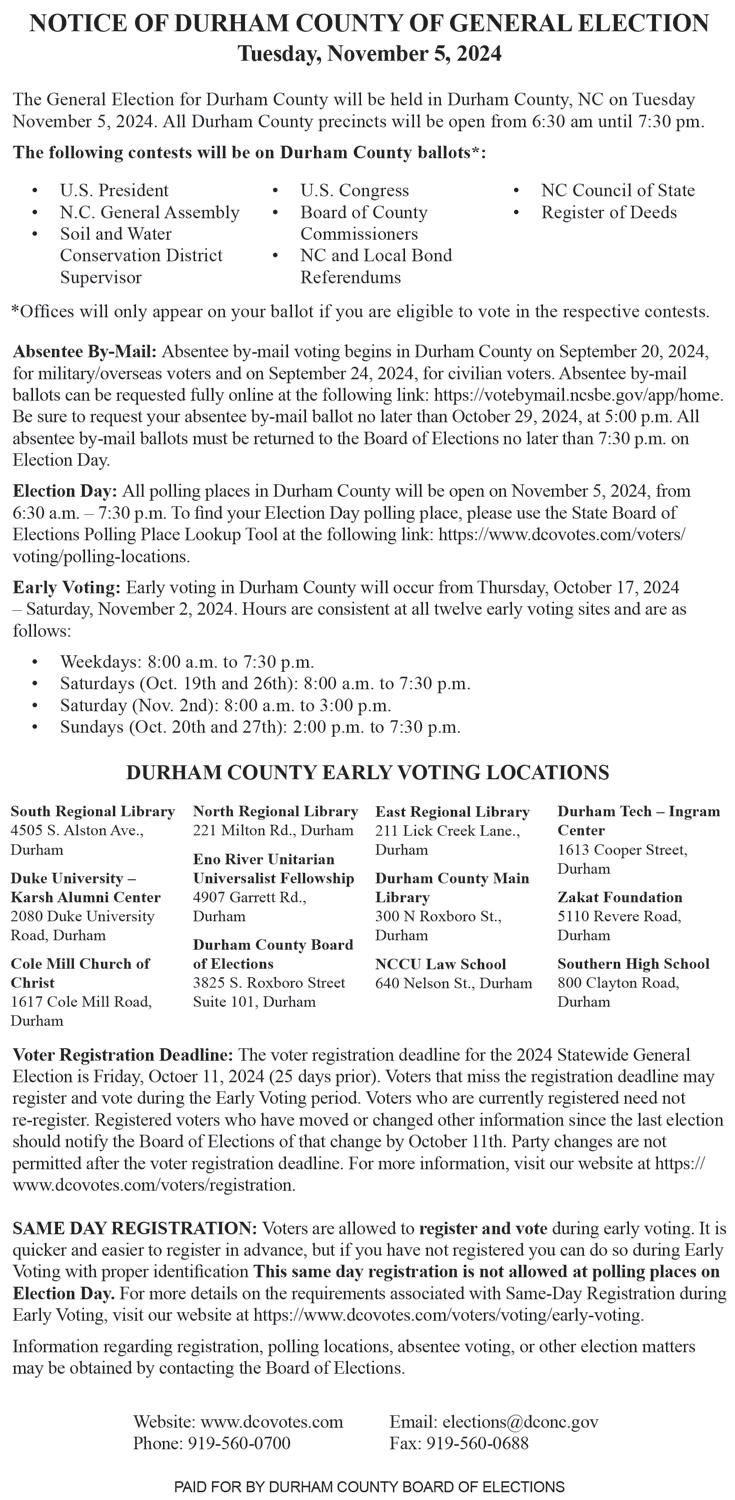

Durham Public Schools now offers free meals to students, with dynamic menus featuring items like chana masala and chicken teriyaki and some ingredients sourced locally.
BY CHASE PELLEGRINI DE PAUR
chase@indyweek.com
“Free breakfast, free lunch,” Anthony Lewis, Durham Public Schools’ (DPS) new superintendent, said at his first Board of Education meeting in August, announcing that any public school student can now receive two free meals a day, no questions asked.
“Say it with me,” Lewis said as the audience broke into applause. “Free breakfast, free lunch.”
It truly is hard not to applaud a program that has led to an increase of about 3,000 more free daily meals (about 1,000 more breakfasts and 2,000 more lunches for a total of about 11,000 breakfasts and 14,000 lunches) served to Durham children, all without requiring their parents to jump paperwork hurdles to prove eligibility.
And, counterintuitively, serving more free meals is actually set to save the district $1.5 million this year.
While Lewis just started his new job, the school board opted into the Community Eligibility Provision (CEP) in the spring. CEP is a federal meal service program that provides reimbursement for free breakfasts and lunches in
high-poverty areas. By relying on district-wide data rather than individual household applications, CEP eliminates the district costs in printing and processing applications.
Administrators say that the ease of participation is the main reason for the increase in the number of kids served this year. And they hope that as more students continue to try the school lunches, the stigma of receiving a free lunch will be further reduced.
But there’s another shift going on at the same time, which DPS officials hope will drive that number of students served even higher: the food at DPS is simply getting better this year.
Just look at the menu. Instead of hot dogs, pizza, and chicken nuggets, students have options like chana masala, chicken teriyaki, and a build-your-own bowl.
“This is part of a much larger shift in school nutrition,” Linden Thayer, assistant director of food systems planning for DPS, tells the INDY.
Artificial colors and flavors, items individually heated
in plastic, and high-fructose corn syrup are out. Culturally relevant meals, food cooked from scratch, and locally sourced ingredients are all in. Some middle and high schoolers have been involved in this process through the youth food policy council, meeting several times a year to give feedback on DPS nutrition.
The expanded free meals program has not been without its challenges, however.
The district used to receive Title I funding based on those free and reduced lunch applications, so Thayer says that coordinators had worried about eliminating the applications. Without those applications, though, Title I funding can still be determined through data on students already eligible for initiatives like the Supplemental Nutrition Assistance Program (SNAP).
“I think there are other districts [in which] Title I folks have concerns,” says Thayer, adding that, if done correctly, the switch should not result in any loss of funding.
The menu switch also involves new training for staff.
“It is harder, it is more work,” says Thayer. “It’s asking a lot of our people and our systems that are not fully prepared. We’re asking them to just take a leap of faith with us.”
Ultimately, Thayer sees this next school year’s transitions as a stepping stone toward even more “lofty goals.”
“People for the last 50 years have seen school food as a poverty program, but it was founded as something much more than that,” says Thayer. “We can get back to this idea that—just like you go to science class and you go to English class—you should just go to lunch class and be nourished and then keep going with your day. And it’s going to take a long time to make that culture shift.” W

In a recent vote, most of Raleigh’s leaders made clear that they think Red Hat Amphitheater is a critical piece of downtown’s future success. A new council will have to figure out how the rest of the puzzle pieces connect.
BY JASMINE GALLUP backtalk@indyweek.com
Dozens of Raleighites wearing red T-shirts turned up at a city council meeting last month to “#SaveRedHatAmphitheater.” Many spoke passionately about the need to keep the performing arts space downtown as the city moves forward with plans to expand the Raleigh Convention Center and close South Street to traffic, while some had reservations about the proposal.
The city council chamber was packed to capacity as people from across Raleigh voiced concerns about the downtown economy, the council’s decision-making, and the future of the capital as a whole.
“If you vote no and allow the amphitheater to get plowed under, Raleigh’s portion of the live music market will go somewhere else, that’s a guarantee,” said David Brower, the executive director of PineCone, a nonprofit that has brought traditional music to Raleigh for 40 years.
“The convention center leaders are pursuing a very aggressive timeline that has not allowed for the important public input that a project of this magnitude deserves,” said Mike Motsinger, a South Street homeowner and president of the Boylan Heights Neighborhood Association.
District B council member Megan Patton, whose district does not include any part of downtown, said she struggled with the decision.
“This has caused me not a few gray hairs, taken a few years off my life,” Patton said. “I’ve received no less than 425 emails … including from members of my own district. People have stopped me in the supermarket who are generally apathetic about city projects, but they’re like, ‘Hey, I need to talk to you about this one.’”
The September 17 vote was the most recent step in the city council’s plan to reshape downtown. While the vote
was ultimately successful—the six council members present at the meeting all voted in favor of the plan—criticism of the city council’s community engagement resurfaced as the plan to relocate Red Hat seemingly blindsided nearby residents and homeowners.
Council member Christina Jones, who was excused from the meeting ahead of the vote because of a family emergency, wrote in a message to the INDY that she remains concerned about the South Street closure.
As the election approaches, a major question on voters’ minds is how the next mayor and city council will handle Raleigh’s growth, particularly downtown, which has been in a state of semicrisis since the COVID pandemic.
Bill King, president and CEO of the Downtown Raleigh Alliance (DRA), says more investment is needed, particularly in public art, streets and sidewalks, and public spaces
like Nash Square and Market Plaza.
“We’ve gotten a lot out of having a good downtown in Raleigh, [but] we’ve got a new level that we’ve got to get to,” he says. “When you have a sad and tired place, it’s not going to be good for anyone. We don’t want downtown to get to that.”
In 2020, following the pandemic lockdown, 44 storefront businesses in downtown Raleigh shuttered for good. Although downtown has recovered somewhat, businesses today are still dealing with longterm fallout from the pandemic, says King. In the past four years, more businesses have opened (184) than closed (147). While things have gotten better, King says they’re still not where they once were, mainly due to new work patterns.
“We see some slight bumps every day of the week from employees, which is good, but it’s still well off of what it was four or five years ago,” King says.
With more people working from home, foot traffic in downtown Raleigh during the week is slow, King explains. Fewer people work in downtown offices, meaning fewer people visit local businesses for lunch or stick around after work for happy hour. Foot traffic on Tuesdays, Wednesdays, and Thursdays is close to pre-pandemic levels, but Mondays and Fridays remain quiet, he says.
Businesses in Glenwood South and the Warehouse District bounced back quickly, but those around Fayetteville Street and Moore Square have been slower to recover. There are still a noticeable number of empty storefronts in the area—about 28 percent around Fayetteville Street—some that were empty before COVID and some that shuttered because of the pandemic.
A few new restaurants opened earlier this year and have become major success stories, King says, but other longtime businesses are still struggling. Overall, it’s a mixed bag.
As Raleigh grows, the DRA is encouraging landlords downtown to be intentional in the businesses they attract. The idea is that “your ground floor is what will fill your upper floors,” King says. “So you should be willing to be creative and flexible with the ground floor, because the type of businesses that we think are cool and interesting, a lot of times they need help.”
“There’s a way for us to [tenant in a thoughtful way] and see it as a bigger, forest-for-the-trees thing of like, ‘Hey, this might not be the highest rent-paying tenant, but boy, do they bring a lot of people here and they bring a lot of value in a different way,’” King says. “And that lets us
sell and fill other things like office space and residential units.”
In the past few years, an increase in incidents of harassment, aggressive behavior, and drug use outside storefronts has harmed downtown businesses, their owners assert.
At a Raleigh committee meeting last fall, business owners rattled off a list of concerning incidents they said have cut down on foot traffic and disincentivized people from visiting downtown. In response, the city and DRA hired private security to patrol downtown. King says it has resulted in lowered crime.
“They’re eyes on the street, they’ll call the police if they can’t de-escalate it themselves,” King says. “It’s given people peace of mind, but they’ve also been able to deter a lot of activity.”
According to the Raleigh Police Department, calls for service have increased in 2024 compared to 2023. But reports of robbery and aggravated assault have decreased in that same span of time, as have officer engagements with drug violations and DWIs. The number of illegal firearms police have seized has gone up dramatically.
Unlike the city-hired private security, DRA’s private security is unarmed. The organization is also implementing a cloudbased camera network to improve visibility downtown, King says.
“It has been effective if you look at the data,” King says. “But also just the feel. I’m down here every day, there is a different feel than there was a year ago.”
King says getting the safety issues under control has helped downtown business owners and visitors feel better, creating momentum “on finally adding some businesses in the Fayetteville Street core,” with several openings scheduled in the next few months. But some argue that increased security is a short-term measure at best.
Finding long-term solutions to mental health issues, homelessness, and drug use involves looking at the root causes, says mayoral candidate Janet Cowell. Over the years, many residents have pushed the city to put more money into an alternative crisis response unit (like Durham’s HEART program), as well as social services such as housing assistance, drug rehabilitation programs, and mental health treatment.
Mayoral candidate Terrance Ruth is also pushing the city to be more proactive in working to solve issues around crime and homelessness.

Source: DRA

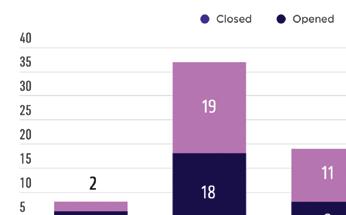
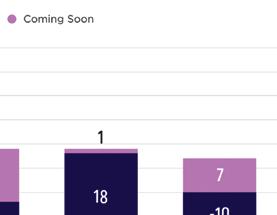


“Right now, it feels like we’re being responsive rather than leading on these particular issues,” he says. “The broad base for growth in our city must include infrastructure … to manage not just traffic … but the data, the information that enters the system, so that we can make sure that we’re responding to that ahead of time.”
The Red Hat Amphitheater vote raised another big issue important to downtown’s future: traffic and street connections. Some worry that the South Street closure will make the area more dangerous for pedestrians. South Street intersects with the busy South McDowell thoroughfare, which already experiences bumper-to-bumper traffic some days.
Council member Jones said that the city’s Planning Commission made some good points about the downsides of the street closure prior to its 5–4 vote against the plan. These are familiar concerns when it comes to big development projects but could be markedly more impactful in downtown Raleigh, where connections are key to the local economy. As areas like Glenwood South and Dix Park thrive, building wider sidewalks and streets that allow people to easily walk from those areas into the downtown core could help Fayetteville Street businesses prosper.
In a recent DRA-commissioned study, consultants recommended building a clear connection between downtown Raleigh and Dix Park, King says.
“Dix Park is where a lot of energy is going. It ought to be properly connected to downtown,” he says.
In downtown proper, King notes that McDowell and Dawson Streets also currently serve as barriers to connectivity, since they’re unpleasant and sometimes dangerous to cross.
“A lot of people … they’ll get to McDowell and Dawson, and unless they have a really compelling reason to keep going, they tend to turn around,” King says.
Creating better connections to downtown is a priority for Cowell, who says one of her last acts as the president and CEO of Dix Park Conservancy was to support an application for federal funding to reconnect neighborhoods isolated by “bad urban renewal projects” such as superhighways.
Cowell says the grant would give the city up to $2 million to figure out a way to bridge Western and Martin Luther King Jr. Boulevards.
“That would be really helpful not only to connect southern downtown to [Dix] Park, but also for Shaw University, which is bisected by this major intersection that is not pedestrian-friendly for Shaw students,” Cowell says.
“The whole idea of reconnecting downtown to all this growth coming into the south, that could be a win-win for everybody.”
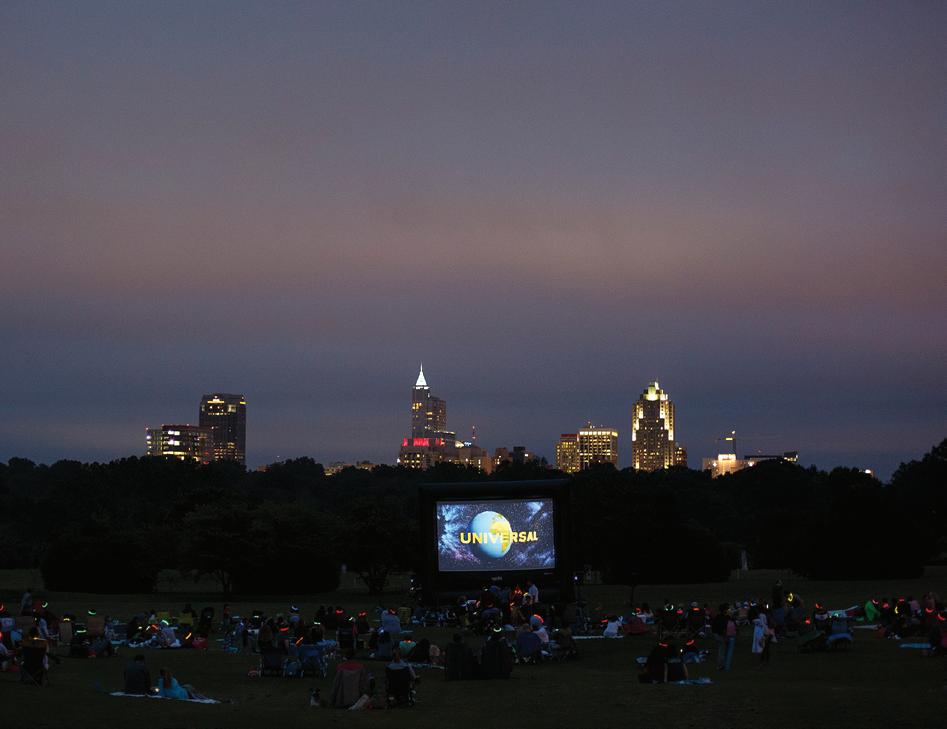
the lead in rejuvenating downtown.
“People love their city. They don’t want to sit on the sidelines. They actually want to help. They want to be engaged,” Ruth says. Giving residents a space to co-design downtown would “allow for all the PhDs we have here, all the rich stories, all the rich lived experiences, all the universities to birth something with the city rather than the city creating something and hoping that the community will take it.”
Downtown is one of the best places to create more residential and commercial density as the city grows, Ruth says. But city leaders should ensure they’re incorporating feedback from residents and investing in the infrastructure to manage that new growth.
Looking to the future of downtown, Cowell says working with the state government to “activate” the Capitol District at street level, as well as giving educational institutions like Wake Tech, N.C. State University, Campbell University, and William Peace University a larger presence in the downtown area will be key. She cites Greenville, South Carolina, where universities such as Clemson and Furman have presences on the downtown’s main street.
town area reconnect after the disconnect of the pandemic.
“For a while, Raleigh had a really strong spirit of collaborative, innovative community. It still has all of that … but the pandemic did disconnect us a bit. We all went home for a year,” he says. “We’re trying to … bring people back together, not just through events, but starting to knit back together some of that ecosystem of ‘OK, let’s get our design community back together. Let’s get our innovation community back together. Let’s get our artists together.’”
As the city grows and private money pours into hubs like North Hills, the Village District, and Iron Works, downtown Raleigh faces more competition than ever for visitors, according to King.
Mayoral candidate Ruth agrees.
“Businesses are trying to make sure that they don’t lose their base,” he says. “That they don’t lose the special vibe that you get with going to a major, successful, and thriving downtown core.”
Ultimately, downtown Raleigh is a true public space, King says, “an opportunity for all types of people to come together and interact.”
The future of downtown
Looking to the future, many Raleighites seem to want the same things: more public art, more music and theater, and a renewed emphasis on the capital city’s history and culture.
It’s just a matter of how to get there.
For mayoral candidate Ruth, creating a “Raleigh Renaissance” means letting residents and business owners take
“[William Peace] is downtown, but there’s ways to strengthen those partnerships and have more presence,” Cowell says.
Overall, Cowell says the city has already made a lot of good investments, it’s just a matter of “linking it together.” She imagines a future where people bike downtown after a day at the N.C. Museum of Art, taking advantage of the city’s existing greenway system.
King has similar ideas. He says he’d like to see the down-
While it’s a tax revenue generator for greater Raleigh, and there’s a financial incentive to investing in it, “it also is the face of the city,” King adds.
“It’s where visitors come when they come to Raleigh, where you take your family when you’re here. It’s where we all come together.” W
This is the third in a four-part series on the Raleigh City Council leading up to the municipal election this fall.
The Regulator Bookshop on 9th Street stands as one of the oldest establishments on a street transformed.
BY VALENTINA GARBELOTTO arts@indyweek.com
As you enter the Regulator Bookshop, your eyes may be drawn to the mural in the children’s section featuring an air balloon and a camel, both carrying books. Or you may notice the “New” section at the entrance, a popular section curated by the owners and employees, featuring new books they’ve enjoyed and the most discussed novels.
The space is small and may not have every book you want. It’s no two-floor Barnes & Noble, and there is no dedicated romance section in sight.
In a world of digital consumption, brickand-mortar bookstores are often seen as antiques of a nostalgic era. Yet the Regulator remains a cherished community staple.
“Part of what Durham is, in so many ways, is the intersection between Duke University and the broader community, and the bookstore is pivotal in that relationship,” former Duke professor Laurent Dubois wrote about the Regulator in the book My Bookstore.
But is the Regulator’s pivotal role enough to guarantee its survival?
Fifty years ago, Duke alum David Birkhead founded the Regulator Press, printing political news for grassroots organizations. Two years later, in 1976, fellow Duke alumni Tom Campbell and Aden Field joined. The trio began selling books, and the Regulator Bookshop was born.
Bearing the name of a group of North Carolinians who spearheaded a revolt against the British in the 1760s, the Regulator embraces nonconformity and progressive values. It has served as a hub for the exchange of ideas, welcoming outspo-
ken authors such as Margaret Atwood, John Hope Franklin, and former vice president Al Gore.
In 1978, following Field’s departure from the bookstore, John Valentine, another Blue Devil, joined Campbell until both retired in 2017 and sold the store to two longtime employees, Wander Lorentz de Haas and Elliot Berger. Campbell and Valentine wanted the bookstore to carry on the culture they forged: championing small presses and catering to the diverse tastes of its community.
Now the Regulator stands as one of the oldest establishments on a street transformed. The Regulator persists even as other bookstores struggle: Durham’s Letters Bookshop recently announced they are shifting from private ownership to a community-owned cooperative for longterm survival.
On a recent Sunday, the soft hum of conversation mingles with the occasional rustle of pages and music curated by the Regulator staff. The tinkling of the doorbell signals the arrival of a young family, whose two children eagerly dart between the bookshelves, heading for the book nook—two worn couches—where other children and adults are reading.
“It’s hard to describe how much the bookshop owes to the community,” says Mika Murphy, 27, a longtime Regulator employee. Local elementary and middle schools hold scavenger hunts that lead them to the bookstore, and book clubs shop for their books at the store.
“Everyone from your teacher or your garbage collector, public service worker, to our state senators and city council peo-

ple come through,” says Murphy. “It’s like a meeting place for people of all walks of life in Durham.”
As bookstores nationwide grapple with the challenges posed by the rise of e-books and online retailers, it’s easy to wonder if they are the next Blockbuster— the multimedia rental chain that ceased operations in 2014.
Bookstore sales plummeted by 45 percent from 2007 to 2019, falling from $16.8 billion to $9.12 billion. Meanwhile, according to Census Bureau data, the number of U.S. bookstores dropped from 12,151 to 6,045 between 1998 and 2019.
Brick-and-mortar bookstores’ biggest competitor is Amazon. Within five years of Amazon’s inception in 1995, the number of independent bookstores declined by 43 percent. Now, Amazon controls over 50 percent of the print-book market and 80 percent of the e-book market.
“Amazon is a concern, though our focus is on books they rarely promote and do not surface easily with their algorithms,” says Lorentz de Haas, one of the shop’s owners.
Durham community member Jonathan Corbin agrees. “Who wants to give up the experience of going to your bookstore?
The calm, safe environment, the smell of books, the friendly people, the opportu-
nity to run across books you could love that isn’t dictated by some algorithm that boxes you in. Need I say more?” he wrote in his Google review of the Regulator.
The store has had to make some changes to survive. The bookstore closed during the pandemic and discontinued in-store events after reopening. The new owners no longer lease the downstairs area, which previously housed events, used books, and a café.
The Regulator has also made some additions. It hosts an online store, where customers can place orders for pickup or delivery. It also has Instagram, Facebook, and X presences.
Yet the store’s in-person sales, aided by its prime location, continue to be its primary source of revenue. As a New York Times–reported bookstore, what the Regulator sells is reported to the Times bestseller lists. The store has been profitable for seven years now, according to its owners.
In fall and other busy times of the year, the bookstore might see between 100 and 200 faces a day, many of them regulars.
“I am very bullish on the future of the shop,” Lorentz de Haas says. “We have made it into a very distinctive shop.”
Until the day an Amazon bookstore opens next to them, he’s not worried. W

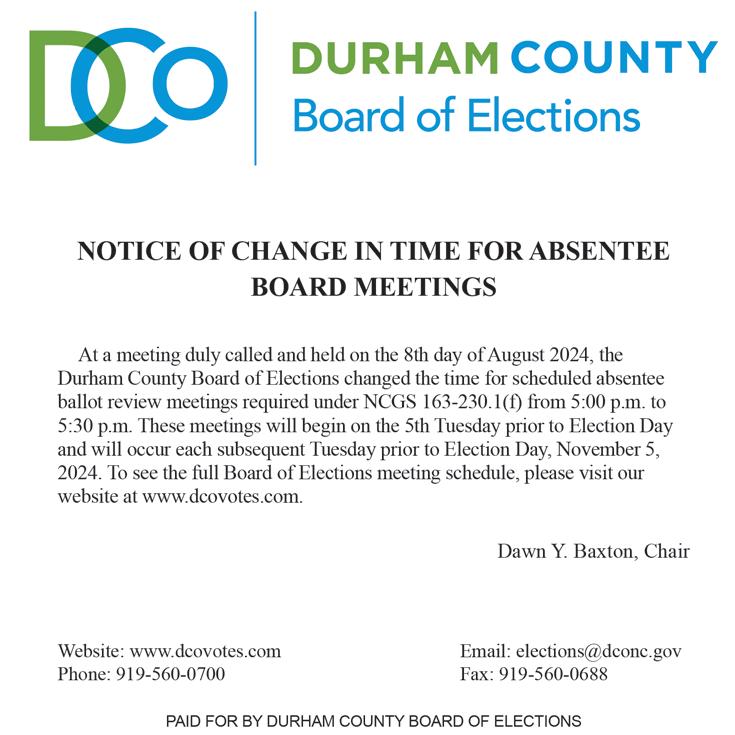

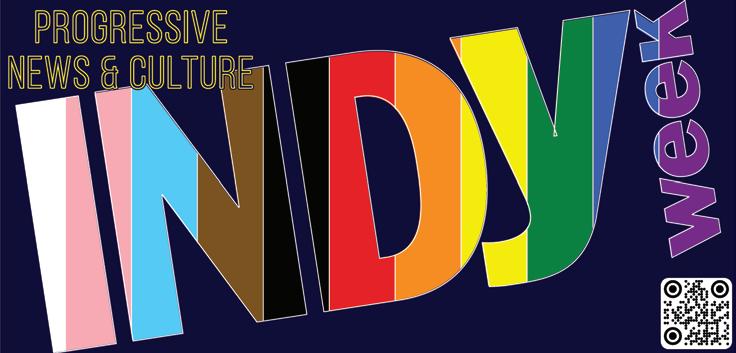


The $142 million bond for Wake County libraries would pay for much-needed updates across the county library system, at a low cost to taxpayers.
BY CHLOE COURTNEY BOHL chloe@indyweek.com
The town of Wendell has outgrown its tiny community library. It’s easy to see why, even before you’ve stepped inside.
The town is buzzing, stretching, bursting with new development. Blocks of townhomes in various stages of construction line the roads, punctuated by backhoes and clear-cut lots ripe for something new. The once-sleepy suburb added 5,000 new residents between 2020 and 2023, bringing its population to 14,400. By 2030, town officials expect that number to double.
The library hasn’t quite kept up. Its single, rectangular room is divided into a children’s area on one side and an adult section on the other. Handmade paper cutouts of trees adorn the walls, and colorful book displays announce the arrival of autumn and Hispanic Heritage Month. There
are a handful of public computers in the back corner, and a friendly librarian sits behind the front desk. It’s the picture of small-town coziness—but like Wendell, it’s bursting at the seams.
This November, the very last question on Wake County ballots will ask voters if they support a $142 million bond to improve the public library system. The bond would pay for a new, bigger library in Wendell, as well as two new libraries in Apex and Rolesville, the replacement of the Athens Drive Community Library in Raleigh, the expansion of the Fuquay-Varina Community Library into a regional library, and much-needed renovations to several other libraries within the system.
The last time Wake County passed a library bond was in 2007, when voters agreed to direct $45 million to library
ILLUSTRATION BY ANN SALMAN
renovations and replacements. In the intervening 17 years, the county has exploded with newcomers and its nationally acclaimed library system has aged.
“We have over a million residents. That is a lot of people that we are trying to offer library service to,” says Katrina Vernon, assistant director of the Wake County Public Library System. “Something that is really core to our mission is making sure that we are building, maintaining, and growing our library system in an equitable way.”
Because Wake County is so large and its population is relatively decentralized, the library system looks a bit different from those in other counties. There’s no main, downtown library; instead, Wake has eight large “regional” libraries and 14 smaller “community” libraries. Even with this decentralized system, there are still many people who don’t live near a library.
One of Wake’s main goals with the library bond is to increase the number of residents who can drive to a library in under 10 minutes. The addition of new libraries in Apex and Rolesville would put 87 percent of the population within that radius, up from 84.7 percent currently.
The bond also contains about $43 million to renovate existing libraries, including new carpets, furniture, roofs, HVAC, and security systems.
“Of course we want to grow our library system,” Vernon says. “But we also want to make sure that our existing facilities are kept accessible, safe, and beautiful and are places that people want to come and use.”
How would the $142 million be spent?
1.) New libraries:
• Community library in Rolesville
• Community library in the Friendship area of Apex
• Replacement of the Athens Drive Community Library
• Replacement of the Wendell Community Library
• A new, TBD facility to promote digital equity
2.) Renovations to eight existing library locations:
• Express Library on Fayetteville Street
• Green Road Community Library
• Leesville Community Library
• Northeast Regional Library
• Richard B. Harrison Community Library
• Southeast Regional Library
• Zebulon Community Library
• Library administration building
3.) Expansion of the Fuquay-Varina Community Library into a regional library
Vernon and her colleagues have spent the past two years assessing the system’s needs and choosing which projects to prioritize. They identified underserved areas and calcu-
lated which libraries have gone the longest without large-scale renovations.
They also decided to replace the Wendell and Athens Drive libraries because the former is too small and the latter is located inside a high school, which county officials decided is suboptimal for students and library patrons alike. Feedback from community members and the Board of Commissioners shaped the bond proposal, which includes money for a “new facility” dedicated to digital equity.
Toni Kenion, a member of the all-volunteer Wake County Library Commission, says the plans for this facility are still in flux. It won’t necessarily be a traditional library, Kenion says, but whatever form it takes, it will be designed to support underserved communities.
The library system’s regular budget doesn’t contain money for these types of projects—it only covers everyday operating costs like buying books and paying staff. To majorly expand and renovate the system, the county needs to raise extra money.
“The most efficient way for us to fund [that] is through a bond,” Vernon says. “So we have to make sure that Wake County voters are in agreement with this, because there is a tax impact.”
If it passes, the bond would cost taxpayers $2.50 per $100,000 of assessed property value per year. That means a homeowner whose house is worth $474,750— the median property value for Wake in April 2024—would pay an extra $11.87 annually. Work would begin in fiscal year 2026 and be staggered over several years.
As Wake County grows, Vernon says libraries are more critical than ever.
“Libraries are the last place that you can go and be there all day, and not have to spend any money, and not be asked why you’re there,” Vernon says.
“We see people who are unhoused, who need a place to stay that is warm or cool, and they’ll be in our facilities all day. We also see people who work from home, and they come in and they work from our facilities all day. We want all of the people to come use the libraries for whatever reason they have—we really do not place judgment on how they use our libraries.”
In preparation for the library bond referendum, Vernon and her colleagues asked the public how they use the library and what they want to see in the future.
“They want the ability to treat [the library] like their living room. They want to be comfortable there,” she says.
Some people come for the books. Others need access to technology and free Wi-Fi. The library has resources for seniors, job seekers, students, and researchers.
“It’s not just a place to borrow books anymore,” says Lisa Mead, who chairs the library commission. “There’s so much additional library programming going on.”
To Lynn Edmonds, a Wake County school board member who also serves on the library commission, investing in libraries is one way to safeguard against censorship and book bans.
“As someone that believes in the freedom to read and is opposed to banning books, if people really want to honor the freedom to read, there is no better way to advocate for that than to support this library bond,” Edmonds says.
Rolesville is the only municipality in the county that doesn’t have its own library. Town officials are eager to see that change with the passage of the library bond.
Rolesville mayor Ronnie Currin says the town has been asking for a library for 17 years. His predecessor, Frank Eagles, advocated for it throughout his 12-year term. Currin has been working on the project since he was elected in 2019. In that time, he says, the town has grown exponentially, and it no longer makes sense for residents to schlep through traffic to visit the library in Wake Forest or Zebulon.
At this point, Currin says, “we need our own—just like we need our own grocery stores.”
The INDY met Currin, Kenion, and Rolesville communications specialist Kandice Scarberry at Rolesville Town Hall to discuss the library bond. All three expressed excitement about the bond and remarked on the relatively small tax impact.
“Let’s say that [you own a] $465,000 home, you’re looking at around an $11.50 tax increase,” Kenion remarks.
“You can’t go to McDonald’s for $11.50!” Currin replies.
Scarberry, 29, grew up in Rolesville, in a low-income household without internet access. She remembers making frequent trips to Wake Forest to visit the library, where she’d pick out books and use the free Wi-Fi.
For families like hers, Scarberry says having a library in town offers “so much potential that people don’t even realize is there.
“They’ve been so accustomed to just dealing with it,” she says. “Making their lives that much easier is so important.” W




Another year, another round of winners in the INDY ’s much-imitated, never-replicated Best of the Triangle contest, where you tell us who’s the best of the best in our beloved region.
While Best of the Triangle has been running for two decades now, astute readers and INDY fans will notice that we’re doing things a little differently. Instead of presenting all winners in all categories, ranging from restaurants, bars, and yoga studios to hair salons, museums, and preschools, all at once, we’re running individual contests and presenting winners in different categories one county at a time—Wake, Durham, and Orange and Chatham—now, we’re on Orange and Chatham Counties.
This year’s list of Orange and Chatham winners, as voted by our readers, is a wonderful reflection of the community in Orange and Chatham Counties and all that they have to offer. You could make a perfect local day—or several—out of dining at the restaurants, touring the parks and museums, and shopping at all the stores for which our readers cast their ballots. There’s so much else to do, too: catch a show, a play, or a movie at one of Orange and Chatham’s premier venues, drop in at a bookstore, or support a local nonprofit.
Thank you for nominating and voting for all of your favorites! Congratulations to all of the finalists in Orange and Chatham who will receive our coveted star decal to display in their windows. Winners will also receive a poster to display in their shop.
Look forward to celebrating all of our winners in all three counties in our special-edition paper in December.
Sarah Edwards Culture Editor

orange
& chatham & chatham
of the Triangle
BEST ALCOHOLIC COCKTAILS THE CRUNKLETON
Runners-up: Belltree Cocktail Club, Eno River Brewing
BEST BAGEL
BRANDWEIN’S BAGELS
Runners-up: The Phoenix Bakery, Bruegger’s
BEST BAKERY
GUGLHUPF BAKE SHOP
Runners-up: Kim’s Bake Shop, The Phoenix Bakery
BEST BARBECUE
HILLSBOROUGH BBQ COMPANY
Runners-up: The Pig, Allen & Son BarB-Que
BEST BEER RETAIL STORE BEER STUDY
Runners-up: Weaver Street Market, House of Hops–Pittsboro
BEST BISCUITS
SUNRISE BISCUIT KITCHEN
Runners-up: Rise Carrboro, Neal’s Deli
BEST BREWERY
ENO RIVER BREWERY
Runners-up: bmc brewing, Top of the Hill Restaurant & Brewery–Chapel Hill
BEST BRUNCH RESTAURANT CAFE ROOT CELLAR PITTSBORO
Runners-up: Small B&B Cafe, Grata Diner
BEST BURGER
AL’S BURGER SHACK
Runners-up: Town Hall Burger and Beer, Shake Shack Chapel Hill
BEST CATERING
MEDITERRANEAN DELI, BAKERY AND CATERING
Runners-up: Al’s Burger Shack, Beau Catering
BEST CHEAP EATS
MEDITERRANEAN DELI, BAKERY AND CATERING
Runners-up: Breadman’s, Al’s Burger Shack
BEST CHEESE SHOP THE CHEESE SHOP
Runners-up: Weaver Street Market, (tied for 2nd) Boxcar Handmade Cheese and Trader Joe’s, Chapel Hill Creamery
BEST CHINESE RESTAURANT
JADE PALACE RESTAURANT
Runners-up: Gourmet Kingdom, Red Lotus
BEST COFFEE SHOP CAFFÈ DRIADE
Runners-up: Open Eye Cafe, Cup A Joe
BEST DESSERTS
GUGLHUPF BAKE SHOP
Runners-up: Kim’s Bake Shop, Crumbl
BEST DRAFT SELECTION
WOODEN NICKEL PUB
Runners-up: House of Hops–Pittsboro, Eno River Brewing

BEST ETHNIC GROCERY STORE
MEDITERRANEAN DELI, BAKERY AND CATERING
Runners-up: Lupitas Meat Market and Taqueria, Mikyin’s Asian Market
BEST FOOD TRUCK
TACOS LOS ALTOS
Runners-up: Bulkogi Food Truck, Drunken Noodles
BEST INDIAN RESTAURANT
VIMALA’S CURRYBLOSSOM CAFE
Runners-up: Lime & Lemon Indian Grill & Bar, Nomad
BEST ITALIAN RESTAURANT
PIZZERIA MERCATO
Runners-up: Magone Italian Grill, Pieros
BEST JAPANESE RESTAURANT
AKAI HANA JAPANESE
RESTAURANT
Runners-up: Spicy 9, Sushi Nikko
BEST LATE NIGHT MEAL –PAST 10 P.M.
WOODEN NICKEL PUB
Runners-up: Time Out, Northside
BEST MEXICAN RESTAURANT
FIESTA GRILL RESTAURANT
Runners-up: Monterrey Mexican Grill, Mi Cancun
BEST NEIGHBORHOOD BAR
ENO RIVER BREWING
Runners-up: Orange County Social Club, House of Hops–Pittsboro
BEST NEW RESTAURANT LA MONTANA
Runners-up: J Dubs Po-Boys, Raising Cane’s
BEST NON-ALCOHOLIC DRINKS
WOODEN NICKEL PUB
Runners-up: Eno River Brewing, Boro Beverage
BEST PIZZA
PIZZERIA MERCATO
Runners-up: Italian Pizzeria III, Alfredo’s Pizza Villa

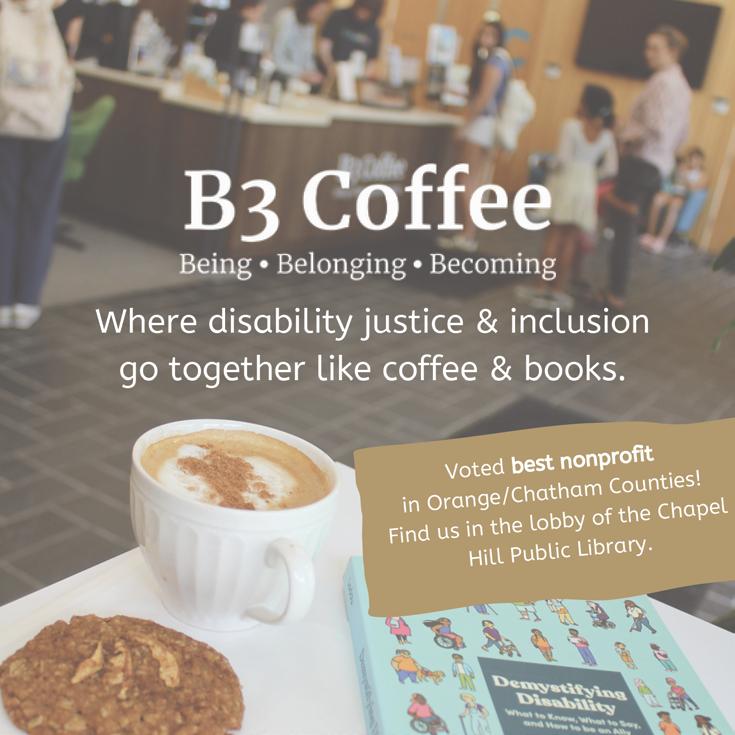
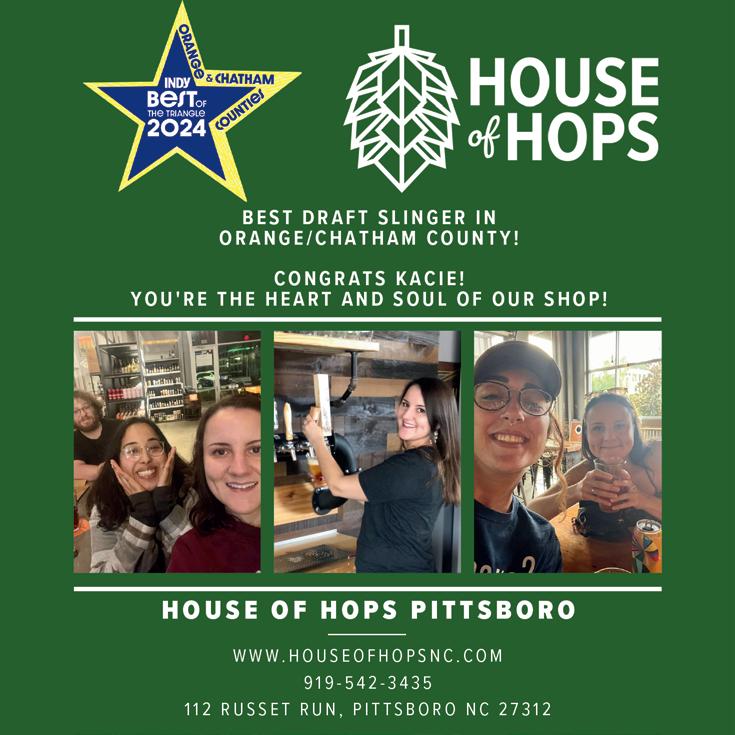
BEST SEAFOOD SQUID’S RESTAURANT
Runners-up: Postal Fish Co., Saratoga Grill
BEST SMALL PLATES/TAPAS GLASSHALFULL
Runners-up: Lucha Tigre, The Beagle
BEST SOUTHERN FOOD MAMA DIP’S
Runners-up: Wooden Nickel Pub, Cafe Root Cellar, Timeout
BEST SUSHI AKAI HANA
Runners-up: Spicy 9, Sushi Niko
BEST THAI RESTAURANT CHAM THAI
Runners-up: Thai Station, Thai Palace
BEST VEGETARIAN EATERY
MEDITERRANEAN DELI, BAKERY AND CATERING
Runners-up: Spotted Dog, Kim’s Bake Shop
BEST WINE LIST
ROCKS + ACID
Runners-up: Bluebird, Vino, House of Hops
BEST WINE RETAIL STORE HILLSBOROUGH WINE COMPANY
Runners-up: Rocks + Acid, Vino’s Wine Shop
BEST WINGS THE WOODEN NICKEL
Runners-up: Heavenly Buffaloes, Carolina Brewery
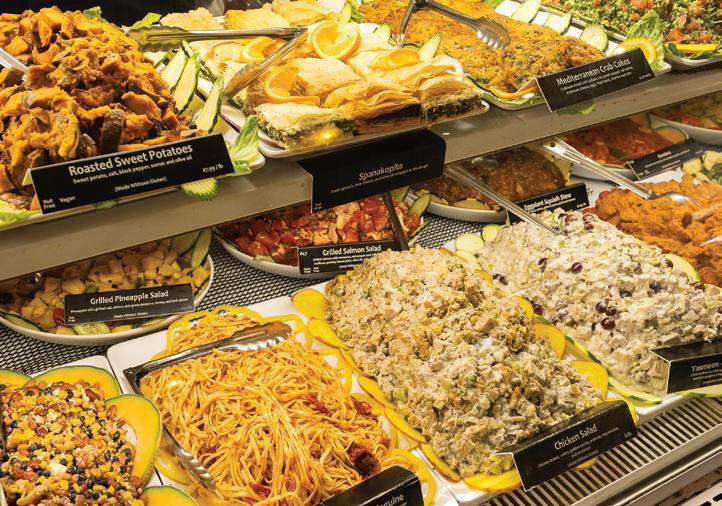


BEST ARBORETUM OR GARDEN NORTH CAROLINA BOTANICAL GARDEN
Runners-up: Montrose, Hartley Henge
BEST DANCE VENUE CAT’S CRADLE
Runners-up: The Kraken, Still Life Chapel Hill
BEST GOLF COURSE FINLEY
Runners-up: Occoneechee Golf Club, Preserve at Jordan lake
BEST HOTEL COLONIAL INN
Runners-up: Siena, Graduate Chapel Hill
BEST HOTEL LOUNGE CAROLINA INN
Runners-up: Siena, Graduate Chapel Hill
BEST KARAOKE PLACE/EVENT WOODEN NICKEL PUB
Runners-up: Northside District, House of Hops Music Bingo
BEST PLACE TO PEOPLE WATCH
WEAVER ST. MARKET CARRBORO
Runners-up: Franklin Street, Shakori Hills GrassRoots Festival
BEST PRESCHOOL/EARLY EDUCATION PROGRAM
LEARNING OUTSIDE
Runners-up: Schoolhouse of Wonder, Binkley Preschool

BEST SPORTS BAR
WOODEN NICKEL PUB
Runners-up: Carolina Brewery, House of Hops, Four Corners
BEST SUMMER CAMP
CAROLINA FRIENDS SCHOOL
Runners-up: Learning Outside, Schoolhouse of Wonder
BEST TRIVIA BAR/EVENT
HAMMERED TRIVIA @ HAW RIVER TAP & TABLE
Runner-up: Eno River Brewing Trivia







BEST CHEF
LESLIE CHARTIER, THE TRAVELLING CAFE & JOHN HORN, WOODEN NICKEL PUB
Runner-up: Sera Cuni at Root Cellar Cafe
BEST DJ
DJ WILDER
Runners-up: DJ Special K at House of Hops, Mista Illz Marcus Ward
BEST DRAFT-SLINGER
KACIE WALKER, HOUSE OF HOPS (PITTSBORO)
Runners-up: James Peery at the Kraken, Vicky Bacskay at House of Hops
BEST KIDS NONPROFIT
SCHOOLHOUSE OF WONDER
Runner-up: Extraordinary Ventures
BEST LOCAL ACTIVIST GROUP
ORANGE COUNTY CFAC
Runners-up: Hillsborough Progressives Taking Action, Love Chapel Hill

BEST MIXOLOGIST
BRITTON MURRAY, WOODEN NICKEL PUB
Runners-up: Zach White at the Belltree, Jess Donnell at Northside District
BEST NONPROFIT
B3 COFFEE
Runners-up: Extraordinary Ventures, Inc., Schoolhouse of Wonder
BEST POLITICIAN
GRAIG MEYER
Runners-up: Jamezetta Bedford, Meaghun Darab
BEST REASON TO LEAVE ORANGE/CHATHAM COUNTY
RISING PRICES
Runners-up: Traffic, Chatham Park
BEST REASON TO LOVE ORANGE/ CHATHAM COUNTY THE VIBES
Runners-up: Green areas, College county
BEST USE OF PUBLIC MONEY SCHOOLS
Runners-up: Affordable housing, Hillsborough Skate Park
BIGGEST WASTE OF PUBLIC MONEY
DEVELOPER INCENTIVES
Runners-up: Construction on Estes, VinFast
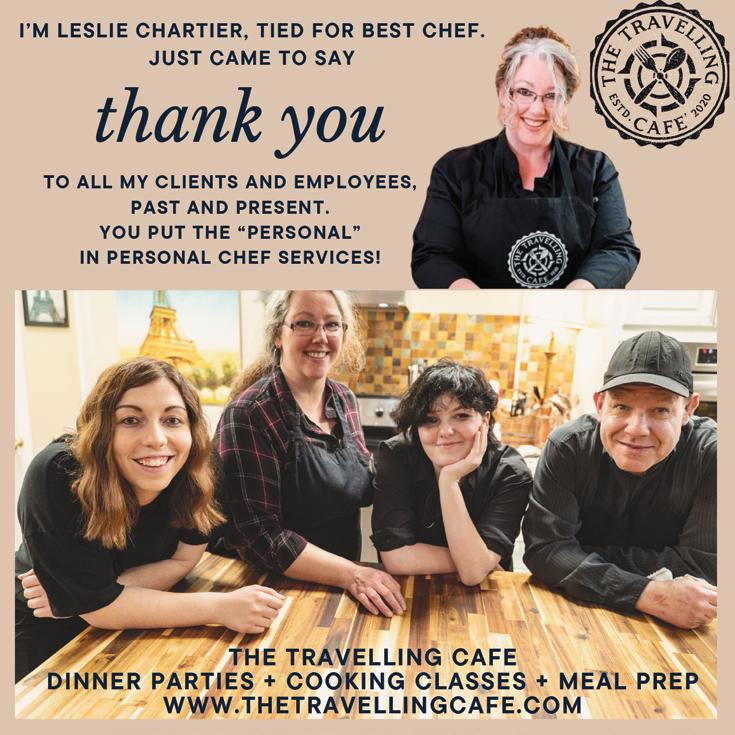
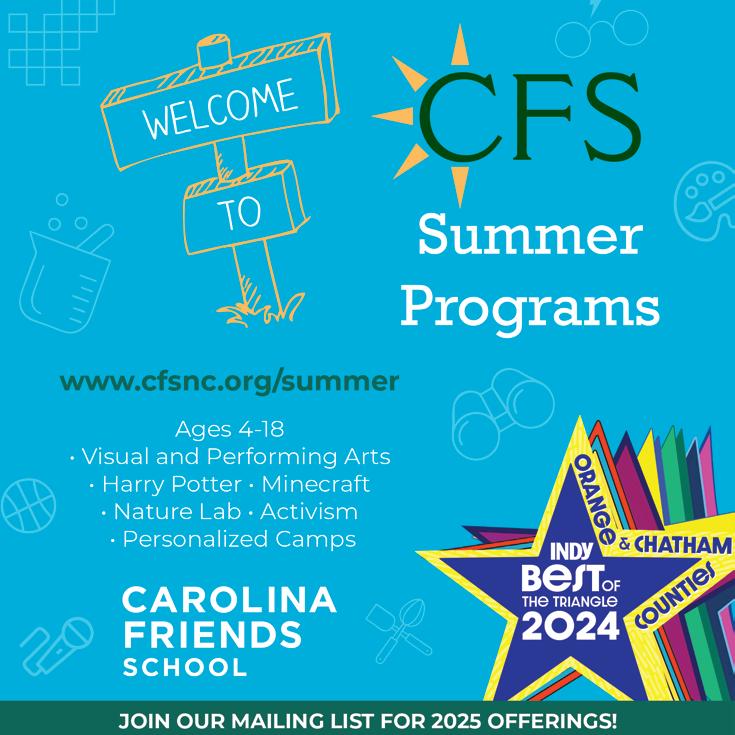

BEST BARBER SHOP FRIENDLY BARBER SHOP
Runners-up: Midway Barber Shop, Cadle’s Barber Shop
BEST CHILDCARE
SCHOOLHOUSE OF WONDER
Runners-up: Casa Club Spanish Immersion, Harvest Learning Center
BEST CHIROPRACTIC PRACTICE
CAROLINA SPINE SPECIALISTS
Runners-up: NC Chiropractic, Circle City Chiro
BEST DENTAL PRACTICE
HOLMAN FAMILY DENTAL CARE
Runners-up: Carrboro Family Dentistry, Cornerstone Family Dentistry
BEST DERMATOLOGICAL PRACTICE
CHAPEL HILL DERMATOLOGY
Runners-up: UNC Dermatology and Skin Cancer Center at Southern Village, Central Dermatology Center
BEST GYM
UNC WELLNESS CENTER AT MEADOWMONT
Runners-up: Planet Fitness Chapel Hill, O2 Fitness Chapel Hill–North Chatham
BEST HAIR SALON MINA’S STUDIO
Runners-up: Great Clips, Ashlyn & Co

BEST HOLISTIC MEDICINE
UNC INTEGRATIVE MEDICINE
Runners-up: Holistic Health & Medicine, Integrative Functional Medicine
BEST MASSAGE THERAPIST
CAROLE L POPE, LMBT # 12671
Runners-up: Jenn Browning, Valory Hicks
BEST PEDIATRIC PRACTICE
CHAPEL HILL PEDIATRICS
Runners-up: Therapy Smarts, Inc., Emerge Pediatric Therapy
BEST SPA
HILLSBOROUGH DAY SPA
Runners-up: The Spa at Fearrington, Edge Salon and Wellness
BEST VETERINARY PRACTICE
CARRBORO PLAZA VETERINARY CLINIC
Runners-up: Hope Crossing Animal Hospital, Vine Veterinary Hospital
BEST WOMEN’S HEALTH PRACTICE
CHAPEL HILL OB/GYN
Runners-up: Planned Parenthood, The UNC Family Medicine Center at Chapel Hill
BEST YOGA STUDIO
FRANKLIN STREET YOGA CENTER
Runners-up: Loving Kindness, YogaSix































of the Triangle orange orange
& chatham & chatham
BEST ATTORNEY CEDAR GROVE LAW
Runners-up: Paynter Law, Kim K. Steffan
BEST AUTO DEALER
MARK JACOBSON TOYOTA (SERVING ORANGE COUNTY)
Runners-up: University Ford Chapel Hill, ABW Imports
BEST AUTO MECHANIC BRAXTON TIRE
Runners-up: Sturdivants, J & W Automotive
BEST CBD/HEAD SHOP
CAROLINA HEMP HUT–HILLSBOROUGH DISPENSARY
Runners-up: Cannabliss, Maxx Vape & Juul
BEST CLOTHING CONSIGNMENT
MY SECRET CLOSET
Runners-up: Rumors, Second Bloom Thrift Shop
BEST DANCE STUDIO
MONARCH MOVEMENT COMPANY
Runners-up: Hillsborough Cheer, Dance, and Gymnastics, Ballet School of Chapel Hill
BEST DOG BOARDING TOP DOG
Runners-up: Green Beagle Lodge, Doggie Day Spa, Love Overboard
BEST DOG GROOMING HAIR OF THE DOG GROOMING STUDIO
Runners-up: Eno Animal Hospital, Livy’s Lavish Self Wash & Grooming
BEST DOG TRAINING TOP DOG
Runners-up: Cheery Dogs, Ryan Ford–Dog Training Camp USA
BEST DOG WALKING KIMIE’S KRITTERS LLC
Runners-up: Walk & Wag, Peace of Mind Pet Sitting
BEST ELECTRICIAN BONNEVILLE ELECTRIC
Runners-up: Klassic Electrical Services Inc., Robert Rockett at Triangle Electric
BEST HVAC COMPANY BOER BROTHERS
Runners-up: Tri Tech Services, Chatham Heating and Air
BEST INSURANCE COMPANY
BONNIE ROSE, NC FARM BUREAU
Runners-up: Pam Herndon State Farm, High and Rubish
BEST JEWELER/JEWELRY STORE
MELISSA DESIGNER JEWELRY
Runners-up: Womancraft Fine Handcrafted Gifts, Rings True
BEST LANDSCAPER ROOTS & SPROOTS
Runners-up: Hillsborough Landscaping, Jeremy Mullis

BEST REALTOR (INDIVIDUAL’S NAME)
BEST LOCAL BOOKSTORE
FLYLEAF BOOKS, CHAPEL HILL
Runners-up: Golden Fig Books, Circle City Books & Music
BEST NEW BUSINESS
ENO RIVER BREWING
Runners-up: Anne and Arthur Fine Art Supply, Finders and Seekers Emporium
BEST PAINTERS
GONZALEZ
Runners-up: Tar Heel Painters, Matias
Painting
BEST PLACE TO BUY LOCALLY MADE ART
WOMANCRAFT FINE
HANDCRAFTED GIFTS
Runners-up: Gold Hand Gallery, Peel Gallery + Photo Lab
BEST REAL ESTATE COMPANY
WEAVER STREET REALTY
Runners-up: Triangle Key by Flex Realty, Premier Agents Network
TERRI TURNER
Runners-up: Carla Sartor, James Blackburn
BEST VINTAGE STORE RUMORS
Runners-up: Reclamation Home Furnishings, Carlisle and Linny Vintage Jewelry


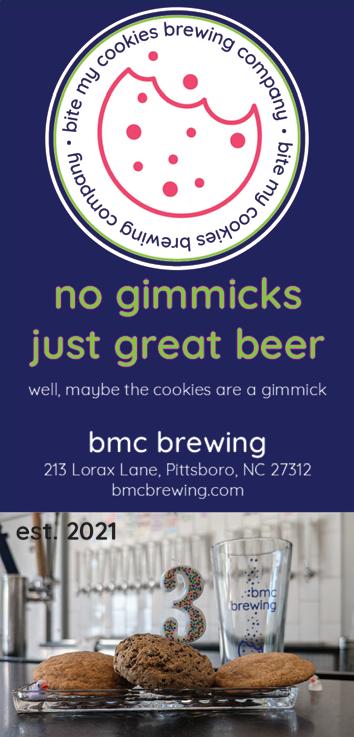

of the Triangle orange orange counties counties & chatham & chatham
BEST ART GALLERY (ART FOR SALE) FRANK GALLERY
Runners-up: Womancraft Fine Handcrafted Gifts, Peel Gallery + Photo Lab
BEST ART MUSEUM ACKLAND ART MUSEUM
BEST COMEDY CLUB/EVENT YONDER: SOUTHERN COCKTAILS AND BREW
Runners-up: The Plant, Cold Brew Comedy
BEST DRAG SHOW/EVENT CARRBORO PRIDE
Runners-up: Drag show w/Kiki Diamond & Friends, Cafe Root Cellar
BEST ELECTRONIC CONCERT VENUE
CAT’S CRADLE
BEST FILM THEATER VENUE/ EVENT
CHELSEA THEATER
Runners-up: Lumina, Center Theater Company
BEST LOCAL/REGIONAL PODCAST WCHL
Runners-up: Aye-aye Pod (Duke Lemur Center), Inside Carolina: A UNC Athletics Podcast
BEST RADIO STATION WUNC
Runners-up: WCHL, WHUP
BEST THEATER COMPANY
PLAYMAKERS REPERTORY, UNC, CHAPEL HILL
Runners-up: Center Theater Company, Company Carolina
BEST UNPLUGGED CONCERT VENUE
CAT’S CRADLE
Runners-up: Community Church Concerts, Nash Street Tavern


University Press Books | October 15, 2024
In his latest book, sports journalist and Duke University alumnus John Feinstein takes readers inside college basketball’s most polarizing program.
BY JUSTIN LAIDLAW jlaidlaw@indyweek.com
When John Feinstein was a student at Duke University in the late 1970s, the basketball team was something of a joke: “When I say to people that Duke was last in the ACC in my four years,” Feinstein tells the INDY, “they think I’m lying.”
It didn’t take long, though, for Mike Krzyzewski, an unknown former Army coach with a hard-to-pronounce last name, to turn the program from a laughingstock to the cream of the crop when he was hired in 1980. Feinstein has been on the sidelines chronicling the Blue Devils’ success ever since.
A New York City native, Feinstein is a decorated journalist and the author of 42 books and counting, including the 1986 classic A Season on the Brink and other New York Times bestsellers, giving voice to some of the most memorable moments in sports. It’s only appropriate that, eventually, he would take readers inside college basketball’s most polarizing program.
Out this month from Duke University Press, Five Banners: Inside the Duke Basketball Dynasty is a fresh look at the histoic program that has hovered near the apex of the college basketball world for nearly four decades. Under Coach K’s tenure, Duke men’s basketball reached the summit five times, winning NCAA national titles in 1991, 1992, 2001, 2010, and 2015. Five Banners reads more like a journal than a history book, with anecdotes from players, coaches, and other important figures throughout the program.
INDY: Duke is such a storied program, and a lot of ink has been spilled. Why write this book now?
JOHN FEINSTEIN: Well, first, to give you the background, my agent is friends with the head of Duke Publishing, whose name is, believe it or not, Dean Smith. And Dean came to my agent and said, “Would John have any interest in doing a sports book for our 100th anniversary?” Dean contacted me and I said, “Well, if they’d let me do what I want to do.” I didn’t want to do a book on the history of volleyball or something like that. I wanted to do a book on something I knew. So I came up with this idea to write about the five championships, since I covered them all, and knew Krzyzewski very well dating back to when he was at Army, showing how old I am. They liked the idea. Dean liked the idea, so I went ahead with it. And I think what I was trying to do—because you’re right, people know the basics of the five championships, and of course, there was a 30 for 30 on Christian Laettner after they won in ’92—so I wanted to write about things I knew but hadn’t written about the program, about Krzyzewski, about guys like Grant Hill and guys like Johnny Dawkins and people like that. And so that’s what I attempted to do—build those stories around the five championships.
You said you wanted to highlight things you had not written about, and I think that really comes through in the anecdotes about players like Nate James and Quinn Cook.
I don’t think anybody wins championships without Nate James, without Quinn Cook. It’s interesting—the 2015 team, which is

considered a one-and-done team because of the three freshmen who starred and then went on right to the NBA—but Quinn Cook, Amile Jefferson, and Marshall Plumlee were very important parts of that team. They don’t win without those guys.
I think that one of the things that has to be learned in the post-Krzyzewski era is that it’s great to recruit star freshmen— they’ve got a kid right now who’s allegedly going to be the number one pick in the NBA draft next year. But you need more than great freshmen. You need those role players. You need those older guys with experience. I think that’s one of the things I tried to explain, especially in writing about the 2015 team. The irony was the 2010 team was the year that Mike had recruited Kyrie Irving but won the national championship with juniors and seniors, because Irving wasn’t there yet. I think John Calipari learned that lesson in recent years.
When did you decide you wanted to start writing books?
Step 1: I had to realize I wasn’t going to be the point guard for the Knicks or play center field for the Mets. I knew that in high school, but when I got to college, I fell in love with newspaper journalism. I was able to write fast because I write like
I talk, so I was comfortable writing fast. I loved covering different things, whether it was straight news, which I did throughout my four years, or covering a Duke fencing team, which I did.
That was also the post-Watergate period, so everybody wanted to be Woodward and Bernstein. I was lucky enough to actually work for Bob [Woodward]. He’s been a great friend to me for more than 40 years now. And I think everybody who writes, whether it’s for a newspaper, a magazine, whatever, wants to write a book at some point. I still remember a friend of mine, Phil Wood, when he interviewed me on this Baltimore talk radio station for A Season on the Brink, said, “Well, I guess everybody who writes has a book in him, and John’s tumbled out.” And I wanted to say to him, the book’s number one on the bestseller list. I think it more than tumbled out.
I actually proposed a book to Dean Smith after [UNC] won the championship in ’82. I always had a good relationship with him, and I said, “OK, you’ve won the championship, that monkey is off your back. You could win again next year”—because they had [Michael] Jordan and [Sam] Perkins coming back. “I’d like to spend the summer reporting on your life and then be around during the season.” He couldn’t have been nicer. He actually said, “Let me think about
it. Let me talk to Linnea [Smith’s wife].” And he called me back and he said, “You know, I’m just not ready to be as honest as I think you’d want me to be about that.” I was 25, and then when I came up with the idea to do A Season on the Brink, I did get the chance. And my goal, Justin, was to write a book that would do well enough I’d get to do a second book. I never dreamed it would be a number one bestseller, so it couldn’t have worked out better for me.
I interviewed Scott Ellsworth, who wrote The Secret Game about Duke and NC Central University. He mentioned A Season on the Brink as something that he really appreciated. He ended up writing a basketball book many years later, but, to your point, his did not just tumble out either.
I don’t think any book tumbles out, to be honest, but, yeah, I’m flattered that Scott would bring up A Season on the Brink because I love that book. And to me, I’m about to start teaching here at Longwood University, and I taught at Duke many, many years ago, before my kids were born. And one of the things, the most underrated things to me about being a reporter, a journalist, an author, is the idea. I’ve always been good at ideas. I’ve rarely taken ideas in my life from editors. One of the things I
learned in my years as a newspaper guy— and I still write for The Washington Post was don’t ever put yourself in the hands of an editor for an idea, because they’ll get it wrong.
What do you remember about Durham from your time as a Duke student? It’s a very different city today than it was in the 1970s and ’80s, and the relationship between Durham and Duke has evolved as well.
There was a lot of culture shock involved. I grew up in New York City. I lived in a neighborhood where I played ball most days with a [diverse] group and I thought everybody was a liberal Democrat. I was shocked when there were guys crying in my dorm when Spiro Agnew resigned. I was running up and down the hall screaming, “Nixon’s next!” But it helped me grow, because I can remember nights in the dorm where we would sit around and argue. Lots of football players lived in my dorm, and they were mostly Midwestern, white, in case of the guys in my dorm, and conservative, and they didn’t understand why I was against the Vietnam War or Richard Nixon. But they were bright guys. So even though we disagreed, it led to very interesting conversations.


I went to a basketball game with my dad in Cameron when I was visiting as a recruited swimmer, and Duke wasn’t any good back then. And when I say to people that Duke was last in the ACC in my four years, they think I’m lying. But they beat Maryland that day. Maryland was second in the country. Gary Melchionni, who was a senior, scored 39 points. And as we walked out, I said to my dad, “I’m sorry,” because he wanted me to go to Yale. He was an active professor there. “If I get in here, I’m going here.” Back then, Durham was still pretty much a tobacco town. There were not many good restaurants. There was the Ivy Room, which we went to. But mostly when we went out to dinner, we went to Chapel Hill. There were good restaurants there, and there were girls. But that was a very different time. Durham is a very different town now. Duke’s a very different school. So like Mike Krzyzewski and coaching the basketball team, I’ve had to adapt to Duke being a different school than the one I graduated from. W

Anne Byrn on possum pie, double-crust blackberry cobbler, and other desserts that have sprung from the American South
BY LENA GELLER lgeller@indyweek.com
Anne Byrn, the cookbook author who gained national prominence in the early 2000s for teaching people how to gussy up boxes of Betty Crocker with add-ins like sour cream and sherry, still embraces her “Cake Mix Doctor” moniker.
But Byrn’s more recent cookbooks have seen her take less of an advisory role and more of a narrative, archival one. Out this month, her latest book, Baking in the American South: 200 Recipes and Their Untold Stories, only includes three of her own family’s recipes. The rest are sourced from department stores, school cafeterias, mills, and churches across the South, drawn from people like “country ham king Allan Benton” and 1930s-era boardinghouse owner Ma Hoyle.
A Nashville native and fifth-generation Tennessean who spent years as a food editor at The Atlanta Journal and The Tennessean, Byrn brings a sense of both familiarity and curiosity to the rigorously researched, effortlessly written Baking in the American South, which features recipes from her home state, plus 13 others.
“If you bake a vast deep-dish fruit pie, in most places in the South, you’ve made a cobbler,” Byrn writes. “But in Surry and Wilkes Counties in North Carolina, the same dish is called a ‘sonker’ …. Sonker was the invention of Scottish and ScotsIrish immigrants, who began settling in the Yadkin Valley of North Carolina in the early 1700s. The word traces to the Gaelic songle or sonkle, meaning ‘little mess.’” Ahead of Byrn’s October 14 reading at the Durham Hotel, the INDY chatted
with her about the research that went into Baking in the American South , the future of hyperregional recipes, and the most iconic baked goods to come out of North Carolina.
INDY: While you were working on this book, how much were you on the road versus doing research and calling on sources from throughout your career?
ANNE BYRN: It was about 50/50. It started as a project that might have been more on the road. But I think because of COVID, the research came first. It was a matter of educating myself about, or trying to figure out: What was the Southern region? If I wanted to include these states, how did I learn about them? Who did I contact in that state? And then, who did I talk to for really broad cultural topics? I wanted to learn about railroads and slavery and rice cultivation and all these topics that had come up.
It really feels like a work of journalism as well as being a functional cookbook.
It was like walking on railroad ties, straddling back and forth between the two.
Why did you decide to take this sort of “reported” approach?
I’ve always asked a lot of questions. I’m a newspaper journalist. I came to cook-
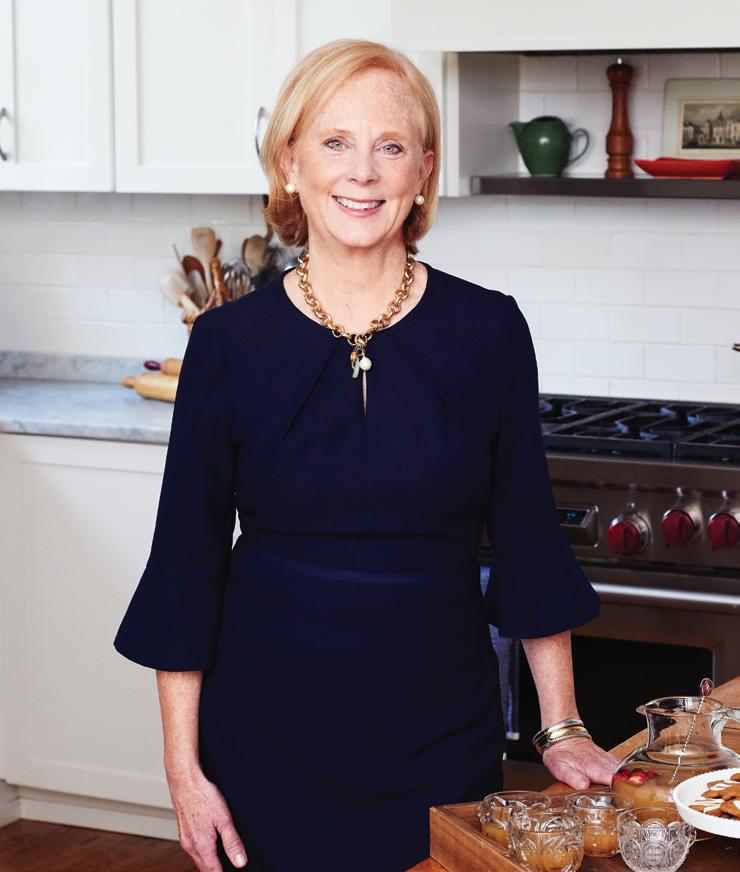
books via newspapers. So I’ve never left that interest in digging out answers and finding people that nobody’s ever heard of, because that would be the type of stories that I would want to report on if there were still newspapers like there used to be. I am not a historian, but I am a curious person and I have always loved the South, and I’ve always loved to bake.
Something that stood out to me in the introduction to the book was you saying that recipes in the South “became hyper-regional because their people were,” but also that recipes transcended state lines; you wrote, “A small town in southern Kentucky was a hub connecting rail lines north and south, allowing imported bananas to travel from docks in New Orleans and
Mobile clear up to New York and Philadelphia, which might explain why there are so many banana pudding recipes embedded in Kentucky cookbooks.” Do you have thoughts on whether we can still be hyperregional in that way—if there are still siloed communities that are coming up with hyperregional recipes?
That’s a real powerhouse of a question. There are some quirky recipes, like the Lane cake and the sticky lemon cheesecake, that are real deep, deep South. I had never heard of those when I grew up in Tennessee. Those recipes stuck in certain communities in part because they were a lot of trouble. They were written about in local cookbooks, but probably because of their expense and the time it took to make them, they just didn’t
go everywhere. Those are also the types of recipes I have some fear about dying out. The Lane cake—and the smell of the whiskey on the counter that goes into the cake—is mentioned in To Kill a Mockingbird, but it’s only sort of just referred to. The Lane cake is also Jimmy Carter’s favorite cake. He’s about to turn 100, so anyone in their 30s may not know, may not really care, that that was Jimmy Carter’s favorite cake.
Whereas something like the banana pudding you mentioned crosses racial lines, economic lines, and state lines because it’s affordable and because people who lived near the docks in coastal cities like Mobile and New Orleans had access to bananas that fell off of the bunches that didn’t get loaded onto the train. I think a lot of it has to do with access and availability and being able to cross lines. I know that’s a mishmash of an answer.
It was a mishmash of a question.
It’s a good one to ponder, for sure. I’m going to keep thinking about it this weekend when I’m at the book festival in Arkansas. Of all the states that had quirky recipes, it’s Arkansas. I’m actually doing a demo at the festival, and when I asked them what kind of recipe they wanted, I was praying they would not say something from Arkansas. Their eyes fell on this pie from Kentucky—it’s a brown-sugar meringue pie, and actually, it’s a great one, because it’s a farm recipe, it’s a fast recipe; you don’t have to caramelize sugar. Anybody can make it. They’ve got these weird recipes—possum pie, cherry nut pie, circe chocolate roll— that you just don’t see anywhere else in the South. And I wonder why.
I’m thinking about how you said that you found a lot of these recipes in print archives. I feel like probably even the super niche, quirky recipes are online somewhere, but there is definitely something to having a curator, someone to dust them off and put them all in one place and platform them.
And test them. A lot of those quirky ones; they weren’t really interesting. The cantaloupe cream pie is a real outlier. We tested that a dozen times to get it right because the flavor was fantastic. It tastes like ripe cantaloupe. I have never seen anything like it. And it spoke of the rail-
roads, it spoke of the ingenious nature of this cook to be able to take this mystery basket of ripe cantaloupe and say, “What the heck am I going to do with this?” and then he makes his pie on a railroad car.
Could you talk a little bit about recipes in the book with origins in North Carolina?
North Carolina is such an interesting state. You have probably birthed more interesting recipes than Tennessee has, but we have something in common in that we’re kind of long and narrow. You have your mountains, and you’ve got your midlands or whatever, and you’ve got your coast, and I think that is very similar to Tennessee, where we have the mountains in the east, the farmland in the middle, and then the Delta in Memphis.

around railroad lines and railroad stops, and that’s where people would stay before there were hotels.
One of the revelations that came out of the mountains of North Carolina is cathead biscuits. I really looked for the story on catheads, because the name is often kind of tossed around just to mean a big biscuit the size of a cat head. It was the research I did into the old logging camps of north Georgia and western North Carolina that I could really place cathead biscuits from that area.
Then there are recipes [that trace back to] the influx of people that came into the middle part of your state (the Moravians, the Germans, the Scots): the sonker, the shortnin’ bread, the Moravian sugar cake. And there are a couple in here that were inspired by Bill Neal, who was the chef in Chapel Hill: the persimmon pudding, the lemon meringue pie. Those are classic Bill Neal because they’re old, and yet they feel very new and modern.
From the coastline, I think of Bill Smith with the Atlantic Beach pie.
Another great North Carolina recipe is Ma Hoyle’s double-crust blackberry cobbler. That came out of Gastonia. It’s a boardinghouse recipe, a type of recipe that would have been common throughout the South, a big pan of cobbler. But what makes it unique is the way she makes it with double crust. Her story was that she started a boardinghouse because she had to support her children and started renting out rooms in her house and cooking. Boardinghouses sprang up
The South was largely rural. It was isolated, and it was poor. This story, I think, feeds into that. Also, blackberries grew wild throughout North Carolina. Recipes like the cobbler that have blackberries tell you that people were foraging for what they had. They were using wild foods in creative ways. And women who could bake could elevate that. They could elevate the ordinary ingredient.
The book really emphasizes all of the contributions that Black women have made to Southern baking. How did you navigate sharing recipes and stories that aren’t from your own culture?
I tried the best I could. When I finished the manuscript, I said, people are just gonna love it or they’re gonna find a million things wrong with it. I put a lot out there. It was very humbling to be able to tell these stories. When it felt like it was getting too difficult, when I felt like, “Should I be talking about this?” I just reverted back to the recipes, and I let the recipes do the talking.
I really wanted to set right out in the very beginning that this is not a book about me. I knew I didn’t want it to be Anne Byrn’s Southern Baking. I wanted it to be about the South. W
This interview has been edited and condensed for clarity.

Downtown Durham shop Mad Kicks is a family affair—and the Triangle’s home base for sneakerheads.
BY ANDREA RICHARDS arts@indyweek.com
For the unfamiliar, sneaker resale stores can be intimidating. Sometimes shoes are wrapped in plastic to protect them, and like in a museum, you’re not sure if it’s permissible to touch the goods.
Also—much like in a museum—there’s an overwhelming abundance of sensorial pleasure: the colors, the styles, the artful display. These are not the racks at Foot Locker or Dick’s, but rather a special place for shoe people, from the casual consumer purchasing a new pair of Pandas to the hypebeast looking for the latest drop. Some pairs of shoes might cost half a paycheck or more; others are less than what you’d pay at a sporting goods store. It’s on you to know why. If you’re a sneakerhead, you probably already know what you are looking for, but there’s always the possibility of surprise, a shoe you didn’t expect to find. Every sneaker store visit is an opportunity, not just to score but to connect.
That last bit I learned from Larry Antunez Lopez and Michel Antunez Lopez, the pair of brothers who own and operate Mad Kicks in downtown Durham, the first sneaker and streetwear shop to grace Main Street. There’s no plastic wrap on the shoes at Mad Kicks and customers can try everything on (this can be a big deal in sneaker stores, which have to worry about creases that devalue the product).
Creating a welcoming brick-and-mortar space is important to the Antunez Lopez brothers, who started their business four years ago in an unused corner of their mother’s Herbalife café on Roxboro Street. Larry, who is now 19, was too young at the time to file the paperwork to start his own business, so he asked Michel, four years his senior, to be his partner.
“He just texted me one day and was like, ‘Hey what do you think of the name Mad Kicks?’ And I was like, ‘Yo, that’s dope,’” Michel says. “I didn’t have the mind for reselling— it was his idea. Our mom had this little 12-by-12 space she wasn’t using, so I was like, let’s make it—let’s open a sneaker store.”
At the time, Michel had recently graduated from Northern High and was already working, so he had some funds to invest ($1,000) to start the store. With help from their

stepfather, a contractor, the teens installed walls and shelves in the Roxboro Street space. “We got the location down; next step: inventory,” Michel says. “We basically started off with two shoes.”
Larry, then 15 and a freshman at Durham School of the Arts, wasn’t living at home and was having a tough time with quarantine: “I started this business because I wanted the latest sneaker,” he says, “but also because it was another way to get out.”
“You had to put a lot of effort for me to even show up to class, let alone when you did it online—I’m definitely not showing up to class,” he adds. “But I knew that I did not want to stay in that position forever. I’ve always had the drive at a young age, and I always knew that I was going to be an entrepreneur somehow, some way—even as a kid, before I even knew what the word ‘entrepreneur’ was. I just knew that I was going to do something for myself, build something.”
“We always had a love for shoes,” Larry adds—he’s wearing an Off-White T-shirt, the brand founded by legendary designer Virgil Abloh. It’s one of several streetwear brands the downtown shop resells, alongside other popular independent labels like Denim Tears, Essentials, Hellstar, Bape, and Supreme. “But we didn’t grow up in the nicest part of Durham—so that’s always just been a dream that, you know, a lot of kids have: ‘Oh, I want the newest Jordans.’ But depending on where you grew up, you can’t always have the latest Jordan.”
“I can’t say that I was a sneakerhead when I started,
because I was still wearing Vans or Converse—whatever my mom could buy,” Larry continues. “I didn’t grab my first pair of sneakers until a couple months after opening the store. It was my birthday, and I was like, OK, I have a sneaker store now. I might as well treat myself.”
Aside from that special pair of Jordan 5 Retro “metallic white,” all the money the brothers made from buying and reselling shoes went right back into the business as they slowly began to grow the inventory. While the first location was small, there was a mural inside the store the brothers painted with a friend that depicted downtown Durham.
“You saw the skyline, the tower, the exact buildings— that’s because every time we walked in me and my brother had a goal,” Larry says of the brothers’ shared vision to move the store downtown. “We are where we wanted to be, back then, but now that we are here, we’ve got new goals.”
By building up from just two pairs of shoes, the Antunez Lopez brothers are, in their own way, replicating the assent of streetwear globally, which came from the ground up, a cultural movement that started in the streets and has grown to influence—and sometimes even eclipse—high fashion.
What started in Black culture based on utilitarian clothing created by a confluence of underground communities in hip-hop, sports, and skateboarding, is so mainstream that today you’ll find it at any mall. But malls are not where you’ll find the coolest stuff, which is harder to come by: the
independent brands that inspire the most awe. For that kind of selection, you’ll have to find a store like Mad Kicks.
Sneaker resale stores are highly curated, reflecting not just the buyer’s eye, but also the people who sell and shop there.
“A huge part of our business is buy/sell/ trade,” Michel says. “We are here downtown with all these new apartments and condos popping up …. A lot of our sneakers that end up on the wall come from our customers.”
The growth in nearby residential units is an asset to the Main Street location, a former attorney’s office that Mad Kicks moved into in October 2023, a few doors down from Bull City Records. Historically, the block was one of the city’s earliest retail areas, though that hasn’t been the case during the last few decades; mostly, you’ll find the fading names of legal firms spelled out across storefronts.
The brothers invested in sweat equity and very little cash to build the store out to what it is today: an inviting, modern space where color-coded sneakers are neatly aligned on shelves that line two walls (the third wall holds racks of clothes).
But with only a handful of apparel stores that are pretty far apart, downtown isn’t a big shopping center and customers can be scarce. (In her response to an email
inquiry, Gina Rozier, the director of marketing and communication for Downtown Durham, Inc., supplies these stats: of the 77 retail stores located downtown, 14 sell apparel and two sell shoes: Mad Kicks and Bull City Running.) Still, regulars and people who work downtown will drop by on lunch breaks to chat. Streetwear and sneaker aficionados drive in from other cities to check Mad Kicks out, spreading the word.
According to Larry, many times people are shocked to hear the location: “It’s like, bro, what?!” he says. “If I told you five years ago, you wouldn’t believe me, because downtown was only a place you went to when you got court or something. Just to say that there’s retail that sells high-end sneakers and clothing in downtown Durham—you got to take that in.”
In July, Mad Kicks organized an event called Mad Streetwear Market to showcase local streetwear designers and sneaker vendors. With food trucks and live entertainment, they hoped to create a space for Triangle independent streetwear brands.
“It’s cooler when you can meet the person who made the clothes instead of supporting big corporations,” says Michel, of the store’s support for local designers and makers. While the event was successful, they can’t get the venue to return calls to plan the next pop-up.
“We want to create a streetwear community here in this city,” Larry explains. “A lot of people think Durham is liberal, that people are always open to more styles and more identities coming through. But sometimes they don’t like that. We had the turnout; it was good, but it wasn’t what [the venue] expected. We reach out and I’m like, ‘Hey, y’all wanted people to pop out and it worked, so can we do it again?’”
“We don’t let that stuff knock us down,” Michel replies.
Since opening, the growing workload has necessitated adding two new store staff members.
“We are on track—we are slowly increasing the team and starting to grow. Hopefully, we open a second location in the future,” Larry says. He’s taking an online real estate course in preparation. (“I’m schooling now,” he jokes when reminiscing about his reluctance to attend high school, which he graduated from in 2023.)
Larry sees Mad Kicks as both a passion project and as part of a portfolio that the two brothers will grow—and continue, always, to own.
“We want people to come in here and to know that whenever they come here, they can talk about shoes, fashion; they can let out,” Larry says. “When people come in, they talk directly to me and my brother.” W


WED 10/2 THURS 10/3 FRI 10/4 SAT 10/5
Ally J on the Roof 7:30 p.m. The Durham Hotel, Durham.
BEAT Tour 8 p.m. The Carolina Theatre, Durham.
Ben Sollee 8 p.m. Motorco Music Hall, Durham.
Micky and the Motorcars 8 p.m. Lincoln Theatre, Raleigh.
SPRINTS 8 p.m. Cat’s Cradle Back Room, Carrboro.
Violent Femmes 8 p.m. Red Hat Amphitheater, Raleigh.
PAGE
Kwame Alexander: Black Star 6 p.m. Quail Ridge Books, Raleigh.
Blue Goose Kaboom / Cuffing Season / Jacks Reese 7 p.m. Cat’s Cradle, Carrboro.
Conan Gray: Found Heaven on Tour 7:30 p.m. Red Hat Amphitheater, Raleigh
HOL! / JKYL & HYDE 8:30 p.m. Lincoln Theatre, Raleigh.
Kishi Bashi 8 p.m. Cat’s Cradle, Carrboro.
Sweat FM / Blisspoint / Distributed Systems 8 p.m. The Pinhook, Durham.
Melissa Ludtke: Locker Room Talk 5:30 p.m. Flyleaf Books, Chapel Hill.
Teletype by Wyat Hamilton Oct. 3-6, 7:30 p.m. KennedyMcIlwee Studio Theatre, Raleigh.
Bathe 8 p.m. Missy Lane’s Assembly Room, Durham.
Carrtoons 8 p.m. Cat’s Cradle, Carrboro.
Chris Botti 8 p.m. The Carolina Theatre, Durham.
Cobalt Blue 5 p.m. The Glass Jug Beer Lab, Durham.
Divine Sweater / Another Michael 7 p.m. The Pinhook, Durham.
The Elovaters Roll Up Tour with Cisco Adler and Bikini Trill 7:30 p.m. Lincoln Theatre, Raleigh.
Lake Street Drive: Good Together Tour 8 p.m. Red Hat Amphitheater, Raleigh.

La Luz 8 p.m. Motorco Music Hall, Durham.
Moodboard: Femi the Femme and DJ HALO
10 p.m. Rubies on Five Points, Durham.
Sankofa Reunion 8 p.m. Cat’s Cradle, Carrboro.
Sepultura Celebrating Life through Death North American Farewell Tour
5:30 p.m. The Ritz, Raleigh.
SLINGSHOT Oct. 4-7, 7 p.m. The Fruit, Durham.
Tar Heel Troubadours: Rissi Palmer and Miko Marks 6:30 p.m. North Carolina Museum of History, Raleigh.
Triangle Oktoberfest Oct. 4-5, various times. Koka Booth Amphitheatre, Cary.
PAGE
Scott Reintgen: The Last Dragon on Mars 6 p.m. Quail Ridge Books, Raleigh.
The ComedyWorx Show Fridays at 8 p.m. ComedyWorx, Raleigh.
SCREEN
Batman in Concert with Live Symphony Orchestra 7:30 p.m. NCMA, Raleigh.
Dayseeker: Dark Sun Protocol 6 p.m. The Ritz, Raleigh.
Fake Fruit / Spllit 7 p.m. The Pinhook, Durham.
Landon Conrath 8 p.m. Cat’s Cradle, Carrboro.
Marauda / Beastoi 8:30 p.m. Lincoln Theatre, Raleigh.
The Moss 8 p.m. Cat’s Cradle, Carrboro.
M. Ward 8 p.m. Haw River Ballroom, Saxapahaw.
Number Drummer Live! 11 a.m. The Carolina Theatre, Durham.
Sarah Kinsley 8 p.m. Motorco Music Hall, Durham.
Tar Heel Troubadours: Henhouse Prowlers
6:30 p.m. North Carolina Museum of History, Raleigh.
Whitney Cummings: Big Baby 7 p.m. The Carolina Theatre, Durham.
Outdoor Films: Spirited Away 8:30 p.m. NCMA, Raleigh.
SUN 10/6 MON 10/7
MUSIC
andmoreagain presents: Mx Lonely / Bluegill / Subverting 8 p.m. The Pinhook, Durham.
Mad Crush / Bass Battery / Cage Bird Fancier 7:30 p.m. Cat’s Cradle Back Room, Carrboro.
STAGE
Matt White 7:30 p.m. Goodnights Comedy Club, Raleigh.
MUSIC
Fib / Nick Normal / Guitar / Saturnalias 7:45 p.m. Cat’s Cradle Back Room, Carrboro.
TUES 10/8
MUSIC
Jeremy “Bean” Clemons Tuesdays at 8 p.m. Kingfisher, Durham.
Wes Parker (of Camp Howard) / Christian James / Good Deal 8 p.m. The Pinhook, Durham.
STAGE
Comedy at Slim’s Dive Bar Tuesdays at 10:30 p.m. Slim’s Downtown, Raleigh.
WED 10/9
MUSIC
Catpack 8 p.m. Motorco Music Hall, Durham.
Vampire Weekend 6:30 p.m. Red Hat Amphitheater, Raleigh.
PAGE
Thorn Mooney: Witches among Us 7 p.m. Quail Ridge Books, Raleigh.
THURS 10/10
MUSIC
The Black Crowes 7:30 p.m. DPAC, Durham.
Blxst: I’ll Always Come Find You Tour 7 p.m. The Ritz, Raleigh.
Braless / Madisinn / Bella Peadon / Taylor Sharp 8 p.m. Cat’s Cradle Back Room, Carrboro.
Casting Crowns: The Awakening Tour 7 p.m. PNC Arena, Raleigh.
Nilüfer Yanya 8 p.m. Cat’s Cradle, Carrboro.
Reyna Tropical 8 p.m. Motorco Music Hall, Durham.
SiR: Life is Good Tour 7 p.m. The Ritz, Raleigh.
Todd Rundgren: ME/WE 8 p.m. The Carolina Theatre, Durham.
PAGE
Joe Posnanski: Why We Love Football 7 p.m. Quail Ridge Books, Raleigh.
STAGE
Copenhagen Oct. 10-27, various times. Burning Coal Theatre Company, Raleigh.

The Hourglass Kids / JULIA. 8 p.m. Cat’s Cradle Back Room, Carrboro.
Joywave: Permanent Pleasure North America
2024 8 p.m. Lincoln Theatre, Raleigh.
Kevin Daniel + The Bottom Line / The Gone Ghosts 7 p.m. The Pinhook, Durham.
Skylar Gudasz Album Release Show 8 p.m. Haw River Ballroom, Saxapahaw.
Trace Mountains / Hannah Cole / The Wigg Report 6:30 p.m. Rubies on Five Points, Durham.
Kwame Mbalia: Jax Freeman and the Phantom Shriek 6 p.m. Quail Ridge Books, Raleigh.
A Few Good Men Oct. 11-27, various times. The Justice Theater Project, Raleigh.
The ComedyWorx Show Fridays at 8 p.m. ComedyWorx, Raleigh.
The Harry Show Fridays at 10 p.m. ComedyWorx, Raleigh.
Inoculation Oct. 11-12, 9 p.m. The Fruit, Durham.
Matteo Lane 8 p.m. DPAC, Durham.
Dana & Alden 8 p.m. Motorco Music Hall, Durham.
The Music of John Williams 8 p.m. Martin Marietta Center for the Performing Arts, Raleigh.
Romain Garcia 9 p.m. The Fruit, Durham.
Saxsquatch’s “Bigfoot Rave” 8 p.m. The Fruit, Durham.
Steve Wynn 7 p.m. The Pinhook, Durham.
Tape B / Levity / Mythm 8:30 p.m. Lincoln Theatre, Raleigh.
Testament / Kreator / Possessed 6 p.m. The Ritz, Raleigh.
The The 8:30 p.m. DPAC, Durham.
The Wildmans 8 p.m. Cat’s Cradle Back Room, Carrboro.
Bob Shea: Pizza for Birds 10:30 a.m. Quail Ridge Books, Raleigh.
Men Are from Mars, Women Are from Venus 7:30 p.m. Martin Marietta Center for the Performing Arts, Raleigh.
NCMA Cinema: Chico and Rita 2 p.m. NCMA, Raleigh.
Outdoor Films: Sister Act Double Feature 7:15 p.m. NCMA, Raleigh.
Ana Bárbara: Reina Grupera Tour 8 p.m. Martin Marietta Center for the Performing Arts, Raleigh.
Artemas 8 p.m. Lincoln Theatre, Raleigh.
COOL COOL COOL 8 p.m. Motorco Music Hall, Durham.
Ray LaMontagne / Gregory Alan Isakov / The Secret Sisters 6 p.m. Red Hat Amphitheater, Raleigh.

MON 10/14 TUES 10/15
BabyJake 8 p.m. Cat’s Cradle Back Room, Carrboro.
Thee Sacred Souls: Live For You Tour 7 p.m. The Ritz, Raleigh.
Vundabar 8 p.m. Motorco Music Hall, Durham.
PAGE
Anne Byrn: Baking in the American South 6 p.m. The Durham Hotel, Durham.
STAGE
David Cross 8 p.m. Cat’s Cradle, Carrboro.
Haughey/Gregory Oct. 14-23, various times. Murphey School Auditorium, Raleigh.
Austin Royale / Monsoon / Colormekrazy 9 p.m. The Pinhook, Durham.
DJ Shadow with Lunice 8 p.m. Lincoln Theatre, Raleigh.
Homeshake 8 p.m. Cat’s Cradle, Carrboro.
Inhaler 7 p.m. The Ritz, Raleigh.
Stephen Sanchez / The Paper Kites 8 p.m. Red Hat Amphitheater, Raleigh.
STAGE
Comedy at Slim’s Dive Bar Tuesdays at 10:30 p.m. Slim’s Downtown, Raleigh.
Being There 7:30 p.m. Varsity Theatre, Chapel Hill.


To download a pdf of this puzzle or view its solution, visit indyweek.com/puzzles-page


© Puzzles by Pappocom
Difficulty level: MEDIUM
There is really only one rule to Sudoku: Fill in the game board so that the numbers 1 through 9 occur exactly once in each row, column, and 3x3 box. The numbers can appear in any order and diagonals are not considered. Your initial game board will consist of several numbers that are already placed. Those numbers cannot be changed. Your goal is to fill in the empty squares following the simple rule above.

If you’re stumped, find the answer keys for these puzzles and archives of previous puzzles (and their solutions) at indyweek.com/puzzles-page or scan this QR code for a link. Best of luck, and have fun!


IT Architect 2
IT Architect 2, IQVIA RDS Inc., Durham, NC.
Hybrid role & must wrk in office 2-3 days/wk. May telcom 1-2 days/wk w/in comutng dist of office. Dsgn, dvlp, intgrate & test tech log & physicl arch to align w/ bus needs. Salary range: $119,198$148,800/yr. Reqs @ lst bach in CS/IS/IT Mgmt/ rel/equiv. Reqs 2 yrs SW dev exp incl 2 yrs: use big data tools & tech like Hadoop, MapReduce, oozie, Cassandra, Hbase, Kudu, Hive, & Spark; arch ETL/ ELT solutns w/ comm tools like Nifi & AWS Glue; dsgn & arch exp supprtng Big Data Pipelines; AWS Data Cloud Pltfrm admin & CI/CD lc; migratng data pltfrms to AWS native data svcs, like Redshift & EMR; use AWS host data cloud solutns like Snowflake & Databricks; create deliv methdlgy & implmnt solutns acc to dsgn/arch; prjct & solutn est & team struc def; arch exp incrprtng mrk & tech condtns; 1 yr: wrk in glbl distribtd team. Reqs up to 5% US & intl trvl. M-F, 8a - 5p w/ occ wknds. Apply: res to usrecruitment@iqvia.com & ref#114623.
Software Engineer
Software Engineer, F/T at Truist (Raleigh, NC) Dvlp customized coding, s/ware integration, perform analysis, configure solutions, using tools specific to the project or the area. Lead & participate in the dvlpmt, testing, implmtn, maintenance, & support of highly complex solutions in adherence to Co. stds, incl robust unit testing & support for subsequent release testing. Must have Bachelor’s deg in Comp Sci, Comp Engg, or rltd techn’l field. Must be an Oracle Certified Java Prof’l. Must have 2 yrs of exp in s/ware / data engg or IT consulting positions performing/utilizing the following: applying in-depth knowl in info systems & ability to identify, apply, & implmt IT best practices; creating analysis & reports to effectively communicate to stakeholders, clarify reqmts & make effective suggestions; understanding of key bus. processes & competitive strategies rltd to the IT function; planning & managing projects & solving complex problems by applying best practices; rationalization between disparate data systems to understand & solve for schema differences during creation or migration of data assets; data analysis to understand & explain the data. Data cleaning & wrangling to transform the data as per bus. reqmt; automating data pipeline processes to create or migrate data assets from one system to another on an ad-hoc or periodic basis; providing direction & mentoring less exp’d teammates; & utilizing exp w/: SQL, SAS, Java or Python, Tableau, Hadoop, Hive, & Spark. Position may be eligible to work hybrid/remotely but is based out of & reports to Truist offices in Raleigh, NC. Must be available to travel to Raleigh, NC regularly for meetings & reviews w/ mgr & project teams w/in 24-hrs’ notice. Apply online (https://careers.truist.com/) or email resume to: Paige.Whitesell@Truist.com. (Ref Job# R0093406)
